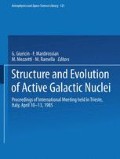Abstract
The evidence for continuity between the observed properties of QSOs and the active nuclei of galaxies of various types is reviewed. It is concluded that the continuity argument is compatible with many of the observations, provided (i) that the idea of directed bulk relativistic motions in many objects which show apparent superlight velocities or very large rapid flux variations is accepted, and (ii) that all of the evidence for the physical associations of QSOs and galaxies, and pairs of QSOs, with very different redshifts, is ignored. Since bulk motions with v ⩾ 0.99c are very difficult to maintain in the presence of any appreciable amounts of diffuse gas, and since much of the evidence for non-cosmological redshifts is compelling, a new approach is outlined. It is proposed that many QSOs and BL Lac objects are gravitationally stable coherent objects which are ejected from galaxies comparatively closeby. They radiate assymetrically, in a cone directed away from their direction of motion. They must he ejected from galaxies with velocities which range from very small values for QSOs with low redshifts which appear to lie in galaxies, to values in the range 0.1c–0.9c for the higher redshift QSOs. Some BL Lac objects may be embedded in galaxies, while some may be coming towards us.
It is suggested that models of this type which imply reduced distances and lower luminosities for the QSOs can be used to explain the full range of phenomena seen. Physical models need to be worked out, since the only mechanism which has so far been proposed to eject coherent objects from galaxies is the slingshot mechanism which appears to give rather low velocities of ejection.
Operated by the Association of Universities for Research in Astronomy Inc., under contract with the National Science Foundation.
Access this chapter
Tax calculation will be finalised at checkout
Purchases are for personal use only
Preview
Unable to display preview. Download preview PDF.
References
Arp, H.C. and Sulentic, J.W., 1979, Ap.J., 229, 496.
Arp, H.C., 1984a, Ap.J., 283, 59.
Arp, H.C., 1984b, Astron. Ap., 139, 240.
Balick, B. and Heckman, T.M., 1983, Ap.J. (Letters), 265, L1.
Boroson, T.A. and Oke, J.B., 1982, Nature, 296, 397.
Boroson, T.A. and Oke, J.B., 1984, Ap.J., 281, 535.
Bridle, A. and Perley, R., 1984, Ann. Rev. Astron. Ap., 22, 319.
Burbidge, E.M., Junkkarinen, V., and Koski, A.T., 1979, Ap.J. (Letters), 233, L97.
Burbidge, G.R., Burbidge, E.M., and Sandage, A.R., 1963, Rev. Mod. Phys., 35, 947.
Burbidge, G.R. and Burbidge, E.M., 1967, Quasi-Stellar Objects, (W.H. Freeman & Co., San Francisco).
Burbidge, G.R., 1979, Nature, 282, 451.
Burbidge, G.R., 1981, Annals, N.Y. Acad. Sci., 375, 123.
Burbidge, C., 1985, A.J., in press.
Burbidge, C., Narlikar, J.V., and Hewitt, A., 1985, submitted to Nature.
Cohen, M.H. and Unwin, S.C., 1984, I.A.U. Symp. 110, VLBI and Compact Radio Sources, Eds. R. Fanti, K. Kellermann, G. Setti, (D. Reidel: Dordrecht), p. 95.
Danziger, I.J., Bergeron, J., Fosbury, R.A.E., Maraschi, L., Tanzi, E.G., and Treves, A., 1983, M.N.R.A.S., 203, 565.
DeYoung, D., 1984, Science, 225, 677.
Gehren, T., Fried, J., Wehinger, P.A., and Wyckoff, S., 1984, Ap.J., 278, 11.
Heckman, T.M., Bothun, G.D., Balick, B., and Smith, E.P., 1984, A.J., 89, 958.
Hoyle, F., 1980, preprint.
Huchra, J., Gorenstein, M., Kent, S., Shapiro, I., Smith, G., Horine, E., and Perley, R., 1985, A.J., in press.
Hutchings, J.B., Crampton, D., and Campbell, B., 1984, Ap.J., 280, 41.
Jones, T.W. and Burbidge, G.R., 1973, Ap.J., 186, 791.
Keel, W., 1985, preprint.
Kellermann, K.I., 1984, preprint.
Kristian, J., 1973, Ap.J. (Letters), 179, L61.
MacKenty, J.W. and Stockton, A., 1984, Ap.J., 283, 64.
Malkan, M.A., 1984, Ap.J., 287, 555.
Malkan, M.A., Margon, B., and Chanan, G.A., 1984, Ap.J., 280, 66.
Margon, B., 1984, Ann. Rev. Astron. Ap., 22, 507.
Osterbrock, D.E. and Dehari, O., 1983, Ap.J., 273, 478.
Richstone, D.O. and Oke, J.B., 1977, Ap.J., 213, 8.
Romanishin, W., Ford, H., Ciardullo, R., and Margon, B., 1984, Ap.J., 277, 487.
Sandage, A., 1973, Ap.J., 180, 687.
Saslaw, W.C., Valtonen, M.J., and Aarseth, S.J., 1974, Ap.J., 190, 253.
Stocke, J.T., Liebert, J., Schild, R., Gioia, I., and Maccacaro, T., 1984, Ap.J., 277, 43.
Stockton, A., 1976, Ap.J. (Letters), 205, L113.
Stockton, A., 1978, Ap.J., 223, 747.
Subramanian, K. and Narlikar, J.V., Quasars and Gravitational Lenses, Proc. Liege Conf., June, 1983.
Sulentic, J.W., 1983, Ap.J. (Letters), 265, L49.
Ulrich, M.H., 1981. Astron. Ap., 103, L1.
Walker, R.C., Seielstad, G.A., Simon, R.S., Unwin, S.C., Cohen, M.H., Pearson, T.J., and Linfield, R.P., 1982, Ap.J., 257, 56.
Wampler, E.J., Robinson, L.B., Burbidge, E.M., and Baldwin, J.A., 1975, Ap.J. (Letters), 198, L49.
Yee, H.K.C. and Green, R.F., 1984, Ap.J., 280, 79.
Author information
Authors and Affiliations
Editor information
Editors and Affiliations
Rights and permissions
Copyright information
© 1986 Springer Science+Business Media Dordrecht
About this chapter
Cite this chapter
Burbidge, G. (1986). Continuity in the Observed Properties of QSOs, High-Redshift Emission-Line Radio Galaxies, BL Lac Objects, N Systems and Seyfert Galaxies, and Possible Interpretations. In: Giuricin, G., Mardirossian, F., Mezzetti, M., Ramella, M. (eds) Structure and Evolution of Active Galactic Nuclei. Astrophysics and Space Science Library, vol 121. Springer, Dordrecht. https://doi.org/10.1007/978-94-009-4562-3_4
Download citation
DOI: https://doi.org/10.1007/978-94-009-4562-3_4
Publisher Name: Springer, Dordrecht
Print ISBN: 978-94-010-8528-1
Online ISBN: 978-94-009-4562-3
eBook Packages: Springer Book Archive

